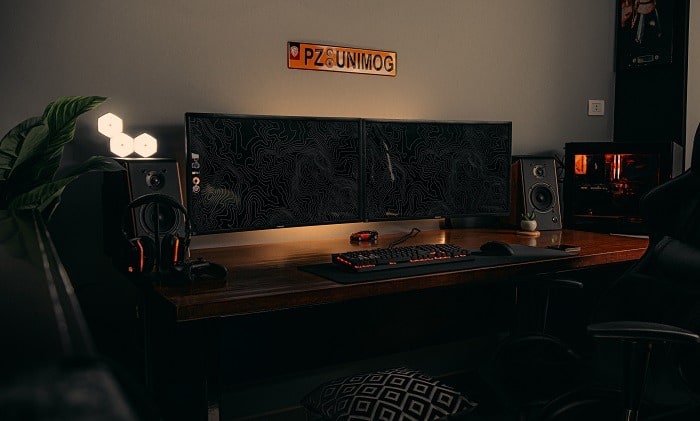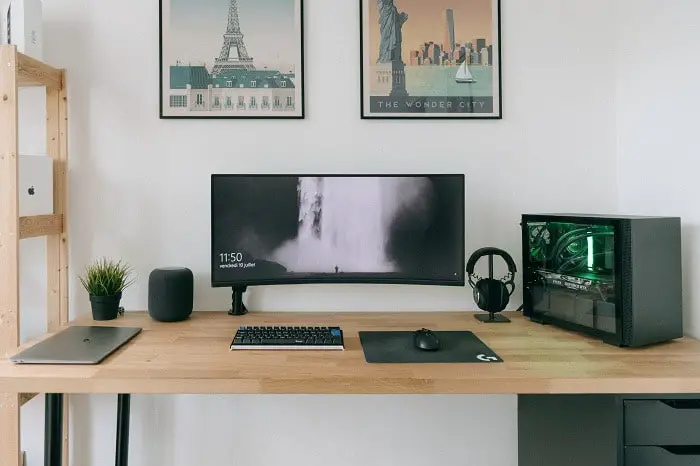Mounting your monitor could be a perfect solution if you often struggle to get a good view of your computer monitor when you’re working. But can you mount a computer monitor on the wall?
Yes! You can. There are many ways to mount a computer monitor which are VESA compliant. But some monitors are neither VESA compliant nor have any mounting holes. In that case, rack mounting, wall mounting, or ceiling mounting are available choices.
This simple modification will allow you to have a clear view of your screen no matter where you’re in the room. So, ready to mount? Keep reading.
Can You Mount a Computer Monitor on The Wall?
As we mentioned earlier, yes, you can mount a computer monitor on the wall. There are many different ways to do this, and here, we’ll discuss the best methods. To mount your monitor on the wall, you must follow three preliminary steps.
Step 1: Find the Correct Holes
First, you will need to find the correct holes in your wall. Then measure where each of your monitor’s mounting screws will go. Then drill into the wall accordingly.
Make sure that you use a good drilling bit and ensure that your hole is deep enough to place the monitor securely on top of it.
Step 2: Install Your Monitor Mounting Brackets
Once the holes are drilled, install the monitor mounting brackets. These brackets will hold your monitor in place while it’s mounted on the wall. They’ll also provide a secure fit for your monitor.
Step 3: Connect Your Monitor to the Mounting Brackets
Now that everything is ready, it’s time to connect your monitor to the mounting brackets. You’ll need to use specific connecting cables for mounting and plug them into the appropriate ports on your monitor.

How to Tell If Your Computer Monitor Can Be Mounted
If you want to mount a computer monitor on the wall, first, you need to make sure your monitor is VESA compliant or not.
Many monitors (including plasma and LCD monitors) can be mounted on the wall, but some won’t sit well. That means, even with a VESA-compliant monitor, you may find it challenging to fit it into the wall in some cases. So, it’s better to buy a separate mounting bracket for your monitor in those cases.
Additionally, certain types of monitors require special care when mounting them on the wall. You’ll need to consult with a professional if you’re not familiar with this process.
What is VESA Standard?
VESA is the most common type of monitor mounting. Virtually all monitors sold in the past several years have been VESA-compliant, and new monitors are as well.
There are a few different types of VESA mounts, such as FDMI MIS-B, FDMI MIS-C, FDMI MIS-D, and FDMI MIS-E. These standards are based on specific measurements, hole patterns, and screw size.
To install a standard monitor mount, you need to measure your wall studs or the thickness of your wall (if you have concrete or cement walls). Most mounts require at least 2” of clearance between the mount and the wall, but some (the “thin-profile” mounts) only require 1.25”, so it’s important to measure first!
Once you’ve determined your monitor mounting requirements, you can begin assembling the mount itself. The basic process is as follows:
- Place the top of the mount onto your monitor base – be sure that both pieces are level!
- Insert the screws into the monitor mount and the wall studs – make sure that they’re properly tightened to ensure stability.
- Install your bottom bracket (if applicable) onto the monitor base and tighten it using the included screws.
That’s it! The new monitor mount is ready to be installed on your wall. Now you can start enjoying crystal clear pictures without having to strain your neck ever again!
Is Your Monitor VESA Complaint?
The most common type of monitor mountings is VESA-compliant, and many new monitors are as well, as we’ve already said.
However, not all monitors can be used with a VESA mount. Some monitors, particularly those that are over a decade old or designed for use with an older graphics card, may not have VESA compatibility.
Those will instead require a special mounting bracket. Suppose your monitor isn’t compatible with a standard VESA mount. In that case, you may need to look into purchasing a specific mounting bracket or using another type of mounting system.
If you’re unsure whether or not your monitor is compatible with a standard VESA mount, contact your monitor’s manufacturer or look for a compatibility guide online.
What If Your Monitor Is Not VESA Complaint?
In case your monitor isn’t compatible with a VESA mount, you’ll need to get a mounting bracket that will fit your specific monitor.
Some manufacturers offer specially designed brackets that work with non-standard monitors. Others may sell third-party mounts compatible with more than just standard monitors.
Check the manufacturer’s website or contact customer service when you’re looking for a mounting bracket that will work with your specific monitor. Many retailers also carry compatible mounts and brackets, so it’s always a good idea to look around before purchasing.

Types of Mounting
When it comes to mounting a computer monitor on the wall, the options you have in your hand are generally two types.
- Mounting monitors that are VESA compliant.
- Mounting monitors that are not VESA compliant.
We’ve already discussed the monitors that are VESA compliant. But when your monitor isn’t VESA compliant, no worries. There are other options available as follows:
Rack Mounting
If your monitor doesn’t have a VESA mount, you can try out a rack mounting system.
A rack mounting system lets you mount your monitor on an individual stand or frameset, which is more convenient than a mounting bracket.
Some of the best rackmount systems include features like integrated audio and USB ports, so you can easily connect peripheral devices.
Desktop Mounting
Another option if your monitor doesn’t have a VESA mount is to purchase a desktop mounting system. A desktop mounting system allows you to attach your monitor directly to the wall or desk using an arm and stand.
Desktop mounting systems are typically more expensive than rack mounting systems, but they offer more stability and flexibility.
Ceiling Mounting
Suppose your monitor doesn’t have a VESA mount, or you don’t want to use a Rack mounting or Desktop Mounting system. In that case, the ceiling mounting system can be a good deal.
Ceiling mounting is a popular option for too large or heavy monitors. It offers excellent versatility because you can move the monitor anywhere in the room.
Wall Mounting
There are two types of wall mounting systems: VESA and non-VESA.
- Non-VESA
Non-VESA wall mounting systems require the purchase of a separate adapter, which–depending on your monitor’s specs–may be included or available separately
- VESA
VESA wall mounting systems are compatible with most monitors that have a Vesa mount hole located at the back or side of the monitor VESA wall mounting systems are the most popular because they’re universally compatible.
If you’re looking to mount a monitor on a horizontal or vertical surface, VESA is the best option. However, if your monitor doesn’t have a VESA mount and you want to use one of the other mounts (Rack Mounting System, Desktop Mounting System), you’ll need to purchase an adapter plate.

How to Mount a Computer Monitor on the Wall
There are a few different ways to mount a computer monitor on the wall. One way is to use an arm and stand, which is typically more expensive than other mounting systems.
Another option is to use a desktop mounting system. It allows you to attach your monitor directly to the wall or desk using an arm and stand.
But, in all cases, the standard procedure is as follows:
- Locate the studs on the wall and mark where they’re with a pencil. Ensure that you do not have any shadowing factor that may impact your mounting options.
- Reach your toolbox and grab a drill bit that is slightly smaller than the diameter of the screw you’ll be using to mount the monitor on the wall (for example, if you’re drilling into drywall, use an 8- inch drill bit).
- Start drilling into the studs, making sure to go slow and steady, so you don’t damage the wall or your monitor. Drive the screw into the bottom of the drill bit, and tighten it with a wrench.
- Repeat this process for each monitor you plan on mounting in your room.
- If you need to remove a monitor from the wall, use a screwdriver to unscrew the screw from the wall. Be careful not to lose your screws or anchors – they’re important for keeping your monitors in place!
Do All Monitors Have Mounting Holes?
No, not all monitors have mounting holes. Some monitors have screw-in mounts that slide into a standard stud. Other models may require the use of an adhesive mount or wall bracket.
How to Mount a Computer Monitor Without Holes?
If your monitor doesn’t have mounting holes, you can still mount the monitor to the wall using a screw and anchors.
- First, measure the distance from the bottom of your monitor to the surface of your wall.
- Second, use a drill bit that’s slightly larger than the screws that are supplied with your monitor and attach it to your drill.
- Third, screw into each stud until you reach the desired height (be sure to tighten every screw once you reach your final height).
- Fourth, use the supplied anchors to hold the monitor in place.
FAQs
- What is the best way to mount a computer monitor on the wall?
There are a few different mounting systems that you can choose from, including an arm and stand, desktop mounting system, or Wall Mounting. Which one is best for you depends on your needs and preferences.
- Can I use my existing cables and wires for mounting a computer monitor on the wall?
Yes, you can use your existing cables and wires for mounting a computer monitor on the wall. However, make sure to consult with an expert if you’re not sure how to mount the monitor securely so that it doesn’t fall later.
- Do I need to buy an expensive special tool in order to mount my computer monitor on the wall safely?
No, you don’t need to buy a special tool to mount your computer monitor on the wall. All you need is a drill bit that’s slightly larger than the supplied screws and anchors.
- Which types of monitors can be mounted on the wall?
Most computer monitors can be mounted on the wall, but make sure to check the specifications of your monitor first. Basically, any type of computer monitor can be mounted on the wall, including flat or angled monitors.
Conclusion
So, can you mount a computer monitor on the wall? The answer is a definitive yes, but there are a few things you need to keep in mind.
For starters, make sure that the wall is structurally sound and able to withstand the monitor’s weight. Also, ensure to measure the available space properly so that you don’t end up having to drill any extra holes in the wall.
Once you’ve figured out all of the necessary details, installation can be done quite easily! Do you have any questions about mounting a computer monitor on the wall? Let us know in the comments below!

Hello Good People! This is Pavel and Welcome to PC Delight!
I’m an Electronics Engineer by profession with a passion for Gaming & PC builds. When I came up with the idea for PC Delight, it was my goal to share & offer the very best PC building ideas to tech-loving people like myself.
Since my school days, I’ve been just addicted to gaming & PCs. That leads me to experiment with various ways around the very niche, resulting in great productivity. And I’m here to share those practical experiences. So that next time you start some experiment with your PC builds or struggle to cope with a certain game, I’m here with the solutions. With these philosophies, I started my journey in 2017 and just kept going.
